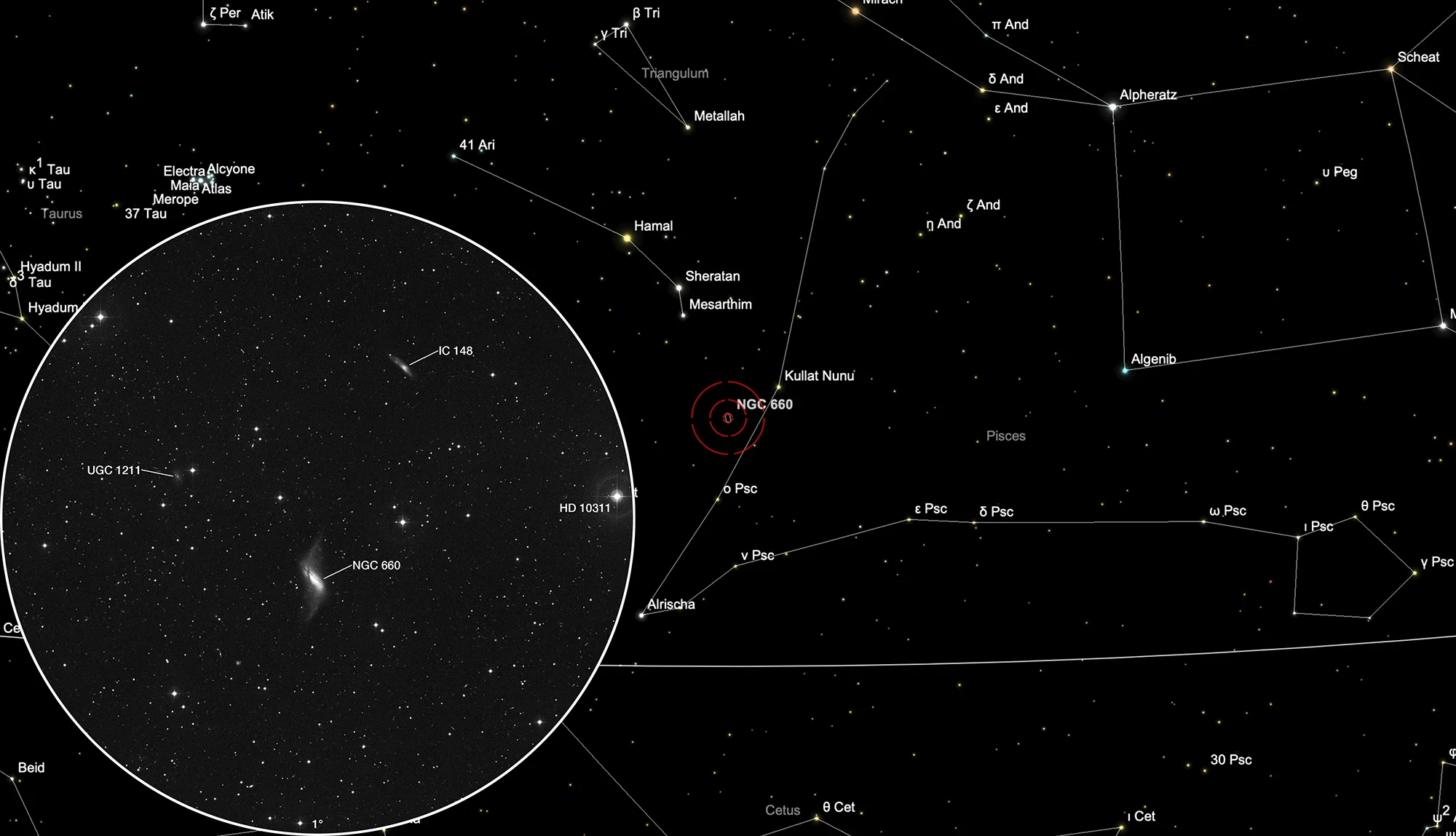Galaxy NGC 660

History
On 16 October 1784 William Herschel discovered a faint nebula which he cataloged as II 253 and noted: «Pretty bright, pretty large, extended brighter in the middle, resolvable.» [463] John Herschel included it in his «General Catalogue» of 1864 with the designation GC 390. [467]
Sir Robert Ball, an assistant of Lord Rosse at Birr Castle observed the nebula with the giant 72 inch telescope and described it as follows: «a fine neb of the character of the neb in Andromeda. Considerably bright, very large, extended E 37.1°, possibly curved and with details. Extended Nucleus which was suspected to be in two parts or have some peculiarity.» A later observation by Dreyer reads «Pretty bright, pretty large, much extended 41°. Looks like a brush, fades away gradually south-following, more sharply defined north-preceding. Condensation in north following end.» [364]
On 30 September 1890 American astronomer Lewis Swift discovered IC 148 using the 12 inch refractor is that at Lick Observatory. [277]
Physical Properties
NGC 660 is a polar ring, starburst galaxy. It has a highly inclined, severely tidally-disturbed disk which is surrounded by a gas-rich, polar ring. Mostly such a feature is prent in elliptical S0 group of galaxies. The disk is viewed close to edge-on with an inclination of 70° and is crossed by a prominent dust lane. The inclination of the ring varies from about 45°-55° with respect to the plane of the disk and is not truly polar. NGC 660 shows signs of an outflow of hot gas along its minor axis. Dust grains located ~2.5 kpc from the stellar disk contribute to this phenomenon. Polarization from scattering is observed away from the minor axis, suggesting possible displacement of grains from the stellar disk due to tidal forces during galactic collisions, likely involving a massive, metal-rich spiral galaxy. Also the presence of a warped disk and the ring is a sign that this galaxy had a collision in the past. [295]
| Name | RA | Dec | Type | bMag | vMag | B-V | SB | Dim | PA | z | D(z) | MD | Dreyer Description | Identification, Remarks |
|---|---|---|---|---|---|---|---|---|---|---|---|---|---|---|
| NGC 660 | 01 43 01.8 | +13 38 37 | Gx (SBa/PRG) | 12.0 | 11.2 | 0.8 | 14.5 | 8.3 × 3.2 | 170 | 0.002835 | 11.97 | 13.450 | pB, pL, E, bM, r | WH II 253; GC 390; UGC 1201; MCG 2-5-13; CGCG 437-12; IRAS 01403+1323; PRC C-13 |
| IC 148 | 01 42 26.9 | +13 58 36 | Gx (Irr) | 13.5 | 12.8 | 0.7 | 14.0 | 3.5 × 1.1 | 50 | 0.002582 | 10.91 | 10.800 | eeF, pS, v diffic, II. 253 sf | UGC 1195; MCG 2-5-11; CGCG 437-10 |
Finder Chart
The galaxy NGC 660 is located in the constellation Pisces. The best time to observe is June to March, when it is highest at night.
Visual Observation
400 mm Aperture: Only the brightest, inner part of NGC 660 was visible as a pale, featureless, oval patch, which appeared slightly clearer in the 13 mm Ethos than in the 21 mm Ethos. Nothing could be seen of IC 148. — 400 mm f/4.5 Taurus Dobsonian, Falera, SQM 20.9, 20. 9. 2025, 01:00 MESZ, Bernd Nies
